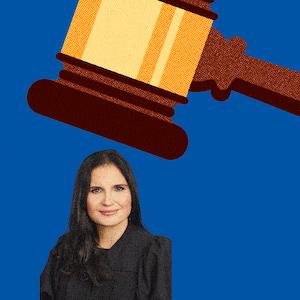When Donald Trump’s legal team filed their court paperwork protesting the Mar-a-Lago raid, a lawyer took the rare step of actually filing the paperwork in person. At a courthouse 44 miles from Mar-a-Lago. And they got a judge to oversee the case that was outside both West Palm Beach—where the raid took place—and the district where they filed.
Those incredible coincidences have led lawyers and legal experts to suggest that something may not be above board with how Trump’s team filed their lawsuit, which serendipitously ended up in the MAGA-friendly hands of Judge Aileen Cannon.
For one, Trump’s team blamed a “technical issue” with the court’s computer system. But The Daily Beast has discovered that the system was working just fine for dozens of other lawyers making hundreds of filings that day.
ADVERTISEMENT
For another, lawyers typically file lawsuits at the district where an issue took place. Trump’s lawyers filed at a courthouse in a neighboring division.
And third, lawyers will mark a case as “related” when it deals with a similar matter. Trump’s legal team did not—despite the fact that another magistrate judge at the right courthouse had approved the FBI’s search warrant to recover those classified government documents from Mar-a-Lago.
“It’s clearly related. I don’t think there’s a plausible argument that it’s not related… it was related to another case in the district—in the same courthouse as a matter of fact,” said Carl Tobias, a law school professor at the University of Richmond.
Questions continue to swirl over how exactly Trump managed to get Cannon, who has shocked legal scholars by issuing mind-boggling orders that always favor Trump. She has temporarily halted the FBI investigation, appointed a “special master” to slow down the probe, and kept the case far from its natural home in Washington, D.C.
“It was basically a home run to get her,” said Loyola Law School professor Jessica Levinson. “They clearly made the correct calculation, because Judge Cannon’s rulings legally don’t make sense. They only make sense if you’re trying to help the former president.”
Levinson said Trump’s team was clearly “judge shopping.”
“They did not want the magistrate judge to make this decision,” she said. “There was already a captain of this ship. They just didn’t like the direction this was taking.”
Trump’s lawyers filed in one division, Fort Lauderdale, selected the venue in a second division, West Palm Beach, and got a judge in a third division, Fort Pierce. And the way Trump handled this matter was odd from the start.
On Aug. 8, the FBI raided Trump’s oceanside estate in Palm Beach. But he did nothing to intervene or legally protest the search over the following two weeks—inaction that surprised two lawyers who have done significant work for Trump or his associates, who told The Daily Beast about their frustration.
It wasn’t until Aug. 22 that Trump finally sued the government to assert his rights were being violated—at a courthouse an hour’s drive south of Mar-a-Lago. A relatively new addition to the former president’s ever expanding cadre of lawyers, the 33-year-old Lindsey Halligan, went in person to the Fort Lauderdale courthouse near her listed address to submit a copy of the 27-page lawsuit, according to a receipt of the transaction. West Palm Beach was selected as the proper venue. The clerks entered the document into the court system at 4:50 p.m.
The move was so peculiar that Trump’s legal team had to explain themselves, which they did in an official document electronically signed by Halligan, Washington lawyer James M. Trusty, and Baltimore attorney M. Evan Corcoran.
“A technical issue with access to the Court’s CM/ECF system precluded electronic filing today, and the CM/ECF Help Desk advised undersigned counsel to file conventionally,” they attested.
To fact-check that, The Daily Beast examined timestamps for all 1,370 court filings made in the Southern District of Florida that day and interviewed lawyers who used the system throughout the afternoon.
Five lawyers who filed documents in the district that day told The Daily Beast that the court’s electronic system was working fine and some even provided receipts that showed their electronic filings were submitted successfully. The district’s head clerk, attorney Angela E. Noble, also confirmed that her court experienced no technical difficulties that day.
Court docket timestamps provide further proof. A lawsuit against a pizzeria was filed electronically at 4:08 p.m. Pissed-off restaurant employees sued their boss over missing tips at 4:14 p.m. A cruise line got sued three minutes later at 4:17 p.m. And the system was still working at 4:43 p.m., just three minutes before Trump’s lawyers filed their lawsuit, when a woman sued over the way she tripped on a pallet at a Costco aisle.
The system was up and running afterwards too, when a food producer sued French businessmen at 5:10 p.m.
When South Florida lawyers who regularly practice in this district were told about Trump’s in-person filing—and the excuse that the system wasn’t working—they all responded with disbelief.
"I don’t know anybody who files in person. I didn’t even know you could do that anymore. It looks like this person was trying to select a particular judge,” one said, suggesting that a Trump lawyer may have had sway with a court employee.
"I find it bizarre. The only people who file in person are ‘pro se,’” said another, referring to people who sue on their own without the help of a lawyer.
“People don’t do this anymore. It’s extremely odd. I guess you could do this if you wanted to get a particular judge—or avoid getting a particular judge,” speculated a third.
For weeks on social media, legal scholars and paid news commentators have been wondering the same thing—and openly suggesting that Trump’s legal team figured out how to game the system.
“Could the 4th estate PLEASE get to the bottom of this,” tweeted former DOJ prosecutor Andrew Weissmann. “If there wasn’t at least the potential to judge shop why on g_d’s green earth would Trump have gone all the way to her district to file and do so physically, when he could have electronically filed at the court in his backyard?”
Lawyers spoke on background, citing a concern that they may have future cases assigned to Judge Cannon.
Some lawyers raised the possibility that Trump’s lawyers tried to be deliberately vague when they blamed “a technical issue with access to the court's” system, which could technically mean they couldn’t get their own computers to work.
“It lacks the ambiance of candor,” one lawyer said. “What do you mean by technical issue? Are you saying the court system was down? Or your computer was down?”
Trump’s own lawyers seem to disprove that notion. In court documents, Halligan attested that she was able to send a copy of the lawsuit “via electronic mail” that day to two Department of Justice lawyers: top Miami federal prosecutor Juan Antonio Gonzalez and Jay I. Bratt, chief of the DOJ National Security Division’s counterintelligence and export control section.
Halligan did not respond to questions for this story.
Trump’s lawyers’ claim that the system wasn’t working makes even less sense when you consider that they could have filed sooner or even later.
“There was nothing that imposed a deadline on them to file. They could have done it the next day,” one South Florida lawyer said.
“I think somebody pulled a fast one in the clerk’s office to rotate it to a friendly judge. It doesn’t sound like it was done by the blind filing system,” mused another.
The Daily Beast contacted a court employee with direct knowledge of how the Trump lawsuit filing was handled, and this person said the case was placed into the federal court system’s automatic random judge “assignment wheel.”
Noble, the head of that office, also said that the proper procedure was followed on their end—and that this is backed up by a log that “is not publicly available.” She said the Trump lawsuit was placed on the West Palm Beach civil wheel, which consists of nine judges. Cannon is in a neighboring division, so she can occasionally get West Palm Beach cases.
Theoretically, that would give Trump a 1-in-9 chance of getting Cannon on the case.
However, The Daily Beast analyzed new case assignments in West Palm Beach in the week preceding Trump’s lawsuit and found that Cannon actually got a much higher share, nine of the 29 new complaints—roughly a third of all cases.
But the system still appears random. The previous Friday in West Palm Beach, Cannon got the first lawsuit of the day. Judge Donald M. Middlebrooks got the next three. Cannon got the last one.
On Monday, Aug. 22, in West Palm Beach, Cannon got the first case. Trump’s lawsuit was the second of the day in that division, and she got that too.
A head clerk of federal courts in another state told The Daily Beast that lawyers sometimes time filings as if they’re players at a casino. Sometimes it works.
“If you play cards and count the cards, I suppose they could say, ‘I’ll hold this here until I see if other judges got assignments.’ But it would be very risky because it’s random,” she said.










